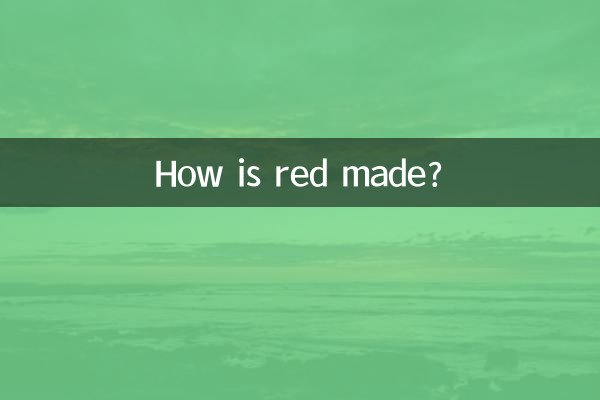How is red made?
As a bright color, red can not only be seen everywhere in daily life, but also plays an important role in art design, printing, digital media and other fields. So, how is red produced? This article will discuss the deployment methods of red from different fields, and give you a detailed analysis based on hot topics and hot content in the past 10 days.
1. The basic concept of red

Red is one of the three primary colors of light, with a wavelength between approximately 620-750 nanometers. In color theory, red can be concocted in different ways, depending on the color model used.
| color model | Red blending method |
|---|---|
| RGB (the three primary colors of light) | R:255, G:0, B:0 |
| CMYK (four colors for printing) | C:0%, M:100%, Y:100%, K:0% |
| HSL (Hue, Saturation, Lightness) | H:0°, S:100%, L:50% |
2. Red applications in hot topics
In the past 10 days, red has appeared frequently in many hot topics. The following are some hot topics:
| hot topics | Red application scenario |
|---|---|
| world cup soccer | The uniforms of many teams are red, symbolizing passion and strength. |
| Metaverse virtual clothing | Red has become a popular choice for virtual fashion design, representing avant-garde and individuality. |
| Spring Festival marketing activities | Major brands have launched red-themed packaging to cater to the festive atmosphere. |
3. The psychological meaning of red
Red has a strong symbolic meaning in psychology and is often associated with the following emotions and concepts:
| emotion/concept | explain |
|---|---|
| passion and love | Red roses are a classic symbol of love. |
| Danger and Warning | Traffic lights and warning signs are mostly red. |
| strength and courage | The flags of many countries and armies feature red elements. |
4. Red blending skills in artistic creation
In the field of painting and design, mixing red requires mastering the following skills:
1.watercolor painting: Using cadmium red or alizarin red as the base color, you can add yellow to create orange-red, or add blue to create purple-red.
2.painting: Traditional Venetian red or Indian red are commonly used pigments, and the brightness can be adjusted by mixing with white.
3.digital design: In software such as Photoshop, in addition to using RGB values directly, you can also fine-tune the red tone through the color balance tool.
| art medium | Red blending suggestions |
|---|---|
| watercolor | Cadmium red + a small amount of yellow = orange-red; Alizarin red + a small amount of blue = purple-red |
| painting | Venetian red + white = pink; Indian red + black = dark red |
| digital design | RGB(255,0,0) is pure red; HSB(0,100%,100%) |
5. Application of red in daily life
Red is everywhere in our daily lives. Here are some common application scenarios:
1.food industry: Red packaging can stimulate appetite. Many fast food brands such as McDonald's and Coca-Cola use red as the main color.
2.fashion industry: Red clothing is very popular during festivals and special occasions. Recent hot searches show that "Chinese red" has become a popular color in winter.
3.home decoration: Red elements can add warmth to a space, and moderate red embellishments can enhance the home atmosphere.
Conclusion
From scientific principles to practical applications, the blending and use of red is a science worthy of in-depth study. Whether in artistic creation, commercial design or daily life, the appropriate use of red can produce strong visual impact and emotional resonance. I hope that through the analysis of this article, you can better understand how red is mixed and flexibly use this charming color in practice.

check the details

check the details